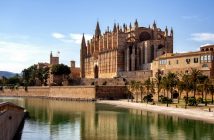It’s rum, cigars and classic cars as Sophie McLean embraces the spirit of Cuba…
As sun slowly sets across the Malecon, colours in Havana’s vibrant sky tonight fade into brilliant pastels that match those of the 1950s cars blazing trails excitedly beneath us. We are standing on the 6th floor balcony of a ‘casa particular’ – a private house, turned BnB that for the next few days will also double as our own quirky Cuban home. With sweeping views across the bay I find myself watching the fading horizon in the company of a man named Francois – someone who has travelled here more times than he cares to count and the second person of that name to stop me in my tracks this year for his charged emotional zeal – one that has been brought about from day-to-day ‘vocation’.
“It’s the world’s biggest bar,” he says indicating the swathe of concrete that lines the northern shore of our view onto the ocean below “…or the world’s biggest sofa. Even in winter.” Francois refers to the Habaneros who come here together to sit, drink and relax for hours on end, under this island’s warming rays. With a twist of the wrist, he opens a bottle of Havana Club 7 year old, and splashes a little on the ground; its dark liquid falling almost in slow motion comparative with our apparent eager surrounds. ‘You have to drop the first drop from the bottle on the floor – it’s good for the spirits.’ Of course, this is a classic Cuban practice – not just the superstition, but the rum itself – something you only have to be 16 years old to purchase here, unlike other alcohol where the legal age is 18.
A few hours later, we are lighting up ‘H Upmann Magnum 46s’ that provide smooth, hazelnut flavoured, pre-dinner aperitifs. In our glasses this time are natural ‘dai-ki-rees’ – and the setting is terraced again. At ‘El Cocinero’, we are at one of the city’s newest nightspots, next to the Fabrica de Arte Cubano – a brilliant concert venue-come gallery space that showcases local and international artistic talent. The crowd inside moves to a new-pitched Cuban beat whilst we, under star-filled skies, cast our eyes to this old factory’s looming terracotta chimney pot, reminiscent of our tightly wrapped rolls of tobacco – their ash growing longer with the night.

Of course Cuba isn’t all just baile, rum and tobacco, even if we are here during the 17th annual Habanos cigar festival that draws a savvy crowd from around the world. If anything, we are here at a pivotal moment for Cuba – privy to what could be next on the cultural development agenda if recent discussions with the US are anything to go by. In evidence, not only is the nightlife exploring notes on a different kind of upbeat, the restaurant scene is flourishing too. Wonderful, family owned, traditional ‘paladares’ are becoming more and more common-place thanks to new decrees passed, and the quality and variety of cuisine is now something worth talking about. Santy, a sushi fusion place found aboard a covert boat, and Pret-a-diner reminiscent ‘Paladar La Guardia’ with its run down mansion walls, are two of the most noteworthy – the latter with décor and dining that are both just as handsome as unexpected.
Despite these progressive signs of economic change, one thing that shows no rapid indication of wavering however are the bright lights of its people. Welcoming from the minute we step into the country, Cuba’s national mosaic is offered to us through the lens of its inhabitants. From the security girls in their uniformly patterned tights at the airport, thumb-worn workers at the Partagas cigar factory – light in their laughter against the socialist and sexual health posters that decorate the walls, or our young city guide whose attitude remains academically inquisitive as he stands in front of Che Guevara’s iron face on the Ministry of the Interior, the charm of Cuba’s ‘village life’ is neatly expressed through its many varied characters.

One person clearly fascinated with Cuba’s people and wider personality was Ernest Hemmingway. Remembered at Finca la Vigia, the house he owned on the island between 1940 until his death in 1961, it was here that he famously wrote For Whom the Bell Tolls (a book rumoured to be one of Obama’s favourites) and The Old Man and the Sea. We visit his house, driven there in a shiny red-brick 1950s Chevrolet by ‘Angel’, who in his panama hat, mirrored sunglasses, and a white shirt that ruffles in the breeze could easily be a protagonist of fiction. ‘The best thing about Cuba’ he says, ‘are the people. They’re so happy. We are a happy nation’.
As a final person in our tale, later that day, at fresco-decorated bar ‘La California’ in Havana’s Old Town, we meet Asbel Morales. Asbel is the master blender of the Havana Club rums. Today he and the team are launching their latest edition to the range – the ‘Union’ – a premium offering from Cuba that for the first time has been paired with a Cohiba Siglo V cigar. Some might call this obvious; others, clever marketing. But official blurb aside, what resonates strongly from Asbel when he offers us a taste is the proud sparkle in his eyes. With a base of reserve rums dating back over many years, this is a piece of heritage bottled – an emblem of Cuban rum expertise and a step up from where the country traditionally sits on the international rum-scene. It is perhaps just as much about Cuban history as any official monument. And a nod to where the future of this culture is headed. In many ways our whole visit is a slant on not just what Cuba is now, but also what it has the potential to be. An up-cycle, of all the best bits yet, with its people – both local, and those visiting, at the centre of its new ‘in-draft’ cover-story.
Integral to Cuba is its rum heritage. Referring, of course, to the national drink. Havana Club operate a rum museum and their website gives an insight on Cuba travel tips and a rich tapestry on the country’s culture. For more information, visit www.havana-cultura.com.




